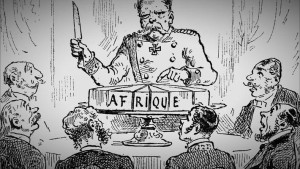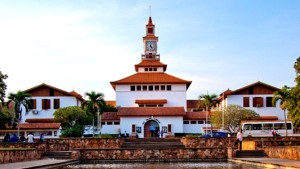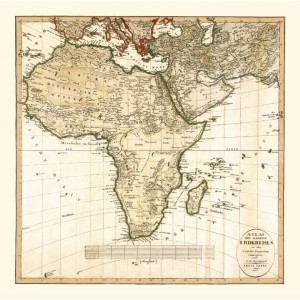International and Internal Migration Dynamics in Africa
 Thursday, Oct. 11 at 7 p.m. Dr. Okyerefo, a renowned professor at the Univeristy of Ghana and student from the Univeritsy of Vienna and University of Cambridge, began his lecture explaining there was an extreme lack of understanding when it came to international and internal migration. He also discussed the fact that the research and data collection between migration patterns was wildly imbalanced and leaning mostly towards international migration. Most recent studies are all focused on the international scope of migration and the effects of global movement; however, much of the migration of Africans is internal to the continent. Dr.Okyerefo divided his lecture content in three main parts each focused on pre-colonial, colonial, and post-colonial respectively.
Thursday, Oct. 11 at 7 p.m. Dr. Okyerefo, a renowned professor at the Univeristy of Ghana and student from the Univeritsy of Vienna and University of Cambridge, began his lecture explaining there was an extreme lack of understanding when it came to international and internal migration. He also discussed the fact that the research and data collection between migration patterns was wildly imbalanced and leaning mostly towards international migration. Most recent studies are all focused on the international scope of migration and the effects of global movement; however, much of the migration of Africans is internal to the continent. Dr.Okyerefo divided his lecture content in three main parts each focused on pre-colonial, colonial, and post-colonial respectively.
Prior to colonial invasion and European imperialism, tribes moved freely as nomadic people allowing them to have alliances and friendships between one another. People were able to move wherever they needed to collect necessary resources or relocate their flocks of animals to graze on greener grasses. Pre-colonialism Africa was one nation undivided by countries’ borders and untouched by foreign powers as access to the continent was a feat within itself considering the dangers of the Sahara desert.
 Still, the transatlantic slave trade began in the late 15th century with Portuguese exploration on the West African Coast and grew from there. Chiefs and traders met the European’s high demand through warfare and increased raiding of villages where they would kidnap women and children. The raiders did always stay on the coast in fear of disease and attack. Families were torn apart and separated, and those taken were treated with no mercy. Then, to further the amount in which Europeans were wreaking havoc on African lives and families, they decided to fully imperialize Africa with the Berlin Conference. European powers all met to find the most profitable division of an entire continent with no regard to landscape, tribal relations, or input from the affected people. African people were divided like sections of a cake and their way of life was completely altered. With movement being restricted by new European ‘masters,’ easy migration was eliminated and people became more isolated within their country, causing those who continued migration to be considered outsiders by others. With the new boundaries dividing Africa and increased activity in the slave trade, the original migration patterns of the African people were forever altered as a result.
Still, the transatlantic slave trade began in the late 15th century with Portuguese exploration on the West African Coast and grew from there. Chiefs and traders met the European’s high demand through warfare and increased raiding of villages where they would kidnap women and children. The raiders did always stay on the coast in fear of disease and attack. Families were torn apart and separated, and those taken were treated with no mercy. Then, to further the amount in which Europeans were wreaking havoc on African lives and families, they decided to fully imperialize Africa with the Berlin Conference. European powers all met to find the most profitable division of an entire continent with no regard to landscape, tribal relations, or input from the affected people. African people were divided like sections of a cake and their way of life was completely altered. With movement being restricted by new European ‘masters,’ easy migration was eliminated and people became more isolated within their country, causing those who continued migration to be considered outsiders by others. With the new boundaries dividing Africa and increased activity in the slave trade, the original migration patterns of the African people were forever altered as a result.
Dr. Okyerefo continued his lecture to discuss modern Africa and how the Berlin conference still has effects today, as the European powers who enslaved and abused Africans also crippled them and their families by prohibiting any sort of development to take place. There is a general political and economic instability within Africa, and due to the historical lack of expansion people are generally migrating to the urban centers that have managed to build themselves up.  In South Africa there were attacks that pushed people North and West, towards developed areas. When there is migration, “people move out of force, they’re displaced by wars ,” said Okyerefo. He spoke of the three types of migration that is occurring- intra-country, inter-country, and intercontinental, all either temporary or permanent. He then went on to say that all of these migration patterns are related by if they’re step migration, replacement migration, or return migration. He related step migration to stepping away from an area due to war and famine- a forced move. Replacement migration is replacing a dwindling population, and return migration is having those who once had moved away come back to their homes.
In South Africa there were attacks that pushed people North and West, towards developed areas. When there is migration, “people move out of force, they’re displaced by wars ,” said Okyerefo. He spoke of the three types of migration that is occurring- intra-country, inter-country, and intercontinental, all either temporary or permanent. He then went on to say that all of these migration patterns are related by if they’re step migration, replacement migration, or return migration. He related step migration to stepping away from an area due to war and famine- a forced move. Replacement migration is replacing a dwindling population, and return migration is having those who once had moved away come back to their homes.
 However, most migration is intra-country or inter-country, still all within Africa, especially with the obstacle of the Sahara Desert. Around the world there are 740 million migrants and 50-80% of households have at least one migrant member. People move to find job opportunities, land for farmers and herders, and to escape from gender inequality. In Kenya there is a common practice of genital mutilation that forces many women to leave the country to find a safer area to live,“People’s circumstances will affect their want to move”. But with all migration there is a key aspect that is often overlooked that is the movement of intellect.
However, most migration is intra-country or inter-country, still all within Africa, especially with the obstacle of the Sahara Desert. Around the world there are 740 million migrants and 50-80% of households have at least one migrant member. People move to find job opportunities, land for farmers and herders, and to escape from gender inequality. In Kenya there is a common practice of genital mutilation that forces many women to leave the country to find a safer area to live,“People’s circumstances will affect their want to move”. But with all migration there is a key aspect that is often overlooked that is the movement of intellect.
Dr.Okyerefo began with brain gain, brain drain, and brain circulation, all effects of migration. Brain drain would be students who receive top notch education in Ghana, and after they’ve received there degree they migrate inter-country and take their knowledge with them. Brain gain is when people move to Africa in general or to receive an education. Lastly, brain circulation are people who are constantly moving and spreading their intellect across the world. Africa as a whole need brain gain and brain circulation to benefit the continent. The more intellectuals, the more of chance there is for further development within countries who still have little to no success in expansion.  These are the areas that need the most help, not the urban centers. Okyerefo noted that the development of Africa needs to become decentralized. They need to overcome, “borders [are] getting thicker and thicker,” and push into countries to create centers for citizens all over Africa to live and become educated, not just in those few urban centers.
These are the areas that need the most help, not the urban centers. Okyerefo noted that the development of Africa needs to become decentralized. They need to overcome, “borders [are] getting thicker and thicker,” and push into countries to create centers for citizens all over Africa to live and become educated, not just in those few urban centers.
The lecture was well rounded and extremely informing on the history of Africa and the people within. He spoke of the need for more competent data that focuses on the internal migration patterns of the African people in order to find the countries that are having the most struggles. More data can allow for more of an impact to occur within the continent that can lead to a more functional society. He finished his lecture by thanking Frostburg and the Faculty Development and Sabbatical Committee for funding his trip here to speak to students and staff.



